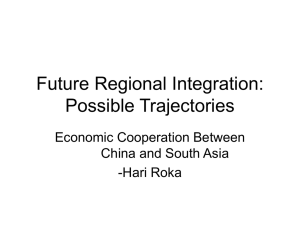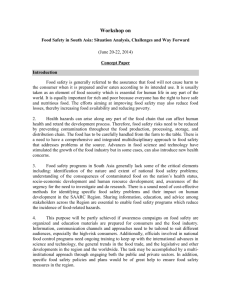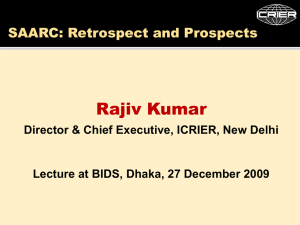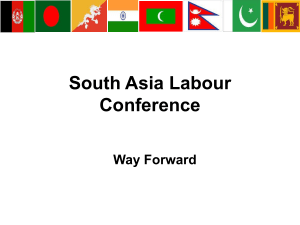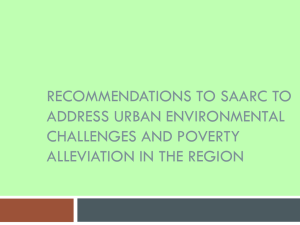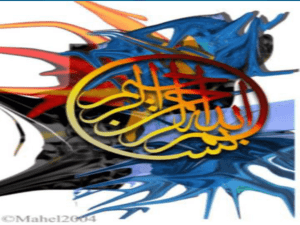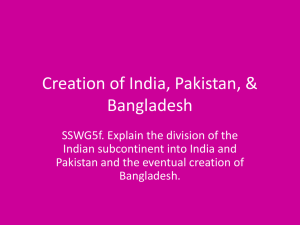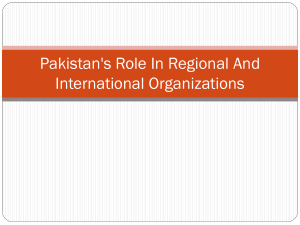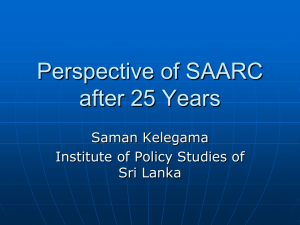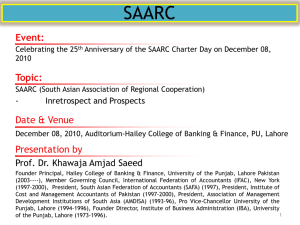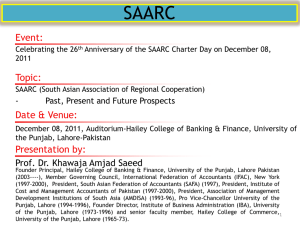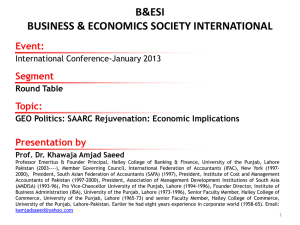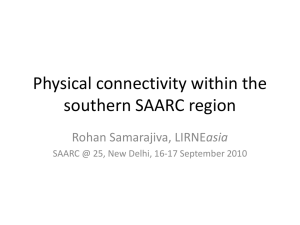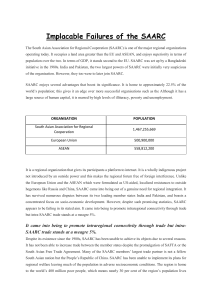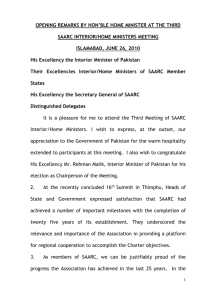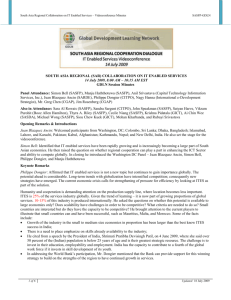Faiqa Umer
advertisement
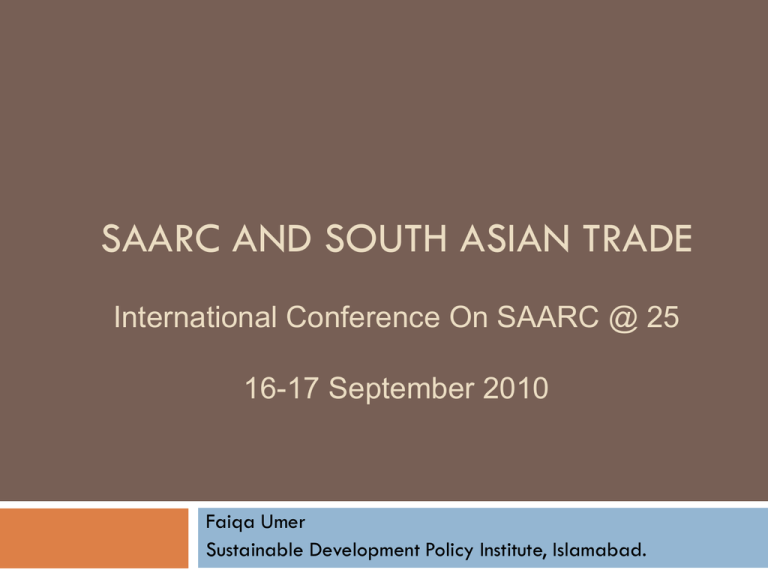
SAARC AND SOUTH ASIAN TRADE International Conference On SAARC @ 25 16-17 September 2010 Faiqa Umer Sustainable Development Policy Institute, Islamabad. Introduction SAARC established in 1985.Member countries: Afghanistan, Bangladesh, Bhutan, India, Maldives, Nepal, Pakistan, Sri Lanka. Core objectives: To promote and strengthen collective self-reliance among the countries of South Asia To contribute to develop mutual trust, understanding and appreciation of one another’s problem To promote active collaboration and mutual assistance in the economic, social, cultural, technical and scientific fields To strengthen cooperation with other developing countries To strengthen cooperation among themselves in international forums on matters of common interest To cooperate with international and regional organizations with similar aims and purposes. Progress so far SAARC celebrated 25 years of existence at its 16th summit held on 28-29 April 2010 in the Bhutanese capital, Thimphu. Formed instruments of regional cooperation South Asian Free Trade Agreement (SAFTA) Convention on Fighting Terrorism SAARC Developmental Goals (SDGs) SAARC Development Fund SAARC Food Bank Observer states include US, Japan, China. Regional agreement on ‘Trade in Services’ Institutions need to address issues of empowerment, and formulate appropriate implementation and monitoring strategies South Asian Trade Intraregional trade is less than 5% of total trade in South Asia (World Bank, 2009) Presence of Tariff and non-tariff barriers Substantial potential for trade due to high population density and geographical proximity. Trade essential to achieve investment, generate employment and mitigate poverty in the region. Intra SAARC trade : exports Growth in Intra-regional Flow of Exports (2003-5) in percent Bangladesh Bangladesh Bhutan India 19.4 57.4 Maldives Nepal Pakistan Sri Lanka 8.4 10.9 25.9 19.2 46.6 13.0 Bhutan India 5.4 13.5 Maldives 11.2 25.1 Nepal -19.7 Pakistan -10.7 Sri Lanka -9.1 -15.2 Source: Direction of Trade, 2006 IMF 6.3 15.5 59.8 58.5 57.9 -6.6 -13.9 14.3 13.3 -40.2 41.8 11.4 Intra SAARC trade: imports Growth in Intra-regional Flow of Imports (2004-5) in percent Bangladesh Bangladesh Bhutan India Maldives Nepal Pakistan Sri Lanka 86.1 15.3 -50.0 -19.7 25.3 4.3 32.8 15.5 40.1 59.0 59.8 22.5 10.4 -13.9 -40.2 Bhutan India 38.7 11.2 Maldives -50.0 28.8 Nepal 8.4 19.2 Pakistan 16.6 Sri Lanka 35.9 -19.6 Source: Direction of Trade, 2006 IMF 64.9 -33.5 26.4 0.0 58.5 10.8 36.9 Indo-Pak Trade Indo-Pak trade: % of Pakistan’s total exports: 1.93 % of Pakistan’s total imports: 3.74 % of India’s total exports: 1.13 % of India’s total imports: 0.31 (ITC, 2006) Indo-Pak Trade 2002-03 2003-04 2004-05 2005-06 Exports US $mn (Pakistan to India) 45 58 95 180 Imports US $mn (India to Pakistan) 206 287 521 689 251 345 616 869 Total US $mn Pakistan indicates that NTBs need to be tackled first before it grants MFN status to India. Indo-Pak trade is being done on the basis of a positive list. Pakistan’s exports to India have grown, however imports from India have grown at a faster pace. Trade Facilitation Measures Comparison of different regions in the world: Indicators South Asia ASEAN NAFTA EU25 World No. of documents for export 8.38 7.69 4.50 4.82 7.22 Days for Export 32.88 29.13 20.50 28.80 28.80 Cost to Export (US$ per container) 1,221.10 732.50 1,101.50 875.30 1,232.00 No. of documents for import 11.31 9.31 5.17 5.64 8.68 Days for import 41.50 29.81 13.17 13.73 32.96 Cost to Import (US$ per container) 1,449.40 834.30 1,569.50 947.60 1,431.00 Source: World Trade Indicators 2008 SAFTA- Key Features… South Asian Free Trade Agreement (SAFTA) signed at the 12th SAARC Summit in Islamabad, Pakistan. Build on SAARC Preferential Trade Agreement (SAPTA) Enhanced scope of regional trade dialogue to include competition, trade and transportation, harmonization of legislation, banking procedures, forex regulations and immigration processes. Trade Liberalisation Programme (TLP): reduce tariffs and eliminate restrictions on quantity of goods traded. Trade not only in goods, but in services and investment too! SAFTA – Key features Non-LDC member states required to reduce existing tariffs to 20 percent within 2 years and then to 0–5 percent in the next 5 years. LDC member countries required to reduce existing tariffs to 30 percent in 2 years and then to 0–5 percent in the next 8 years. Rules of Origin: ensure domestic value addition. Encouraged negotiations for setting ceiling on negative list by each member country. Challenges Political tensions and conflicts in the South Asia region. Obstructions to free movement of people, labor, currency and other forms of capital. Presence of protectionist trade barriers. Multiple bilateral/regional issues or agreements aggravate complexity of issues. Way Forward… Need to move beyond mere framework and policy documents to include practical provisions. Official dialogue between South Asian governments through conferences, meetings and seminars. Advocacy and Outreach campaign: civil society organizations to encourage policy dialogue with South Asian parliamentarians. Develop network of South Asian research institutions focusing on regional trade. Way Forward Ease of travel restrictions between countries. Expand positive list of trade items. Explicit requirement to reduce negative lists over time (instead of 4 year review). Explicit requirement to reduce NTBs. Make rules of origin flexible. Fight against terrorism: regional peace essential to encourage environment conducive to domestic and foreign investment. Economic integration can in turn, pave the way for regional security and social development. Thank You!
